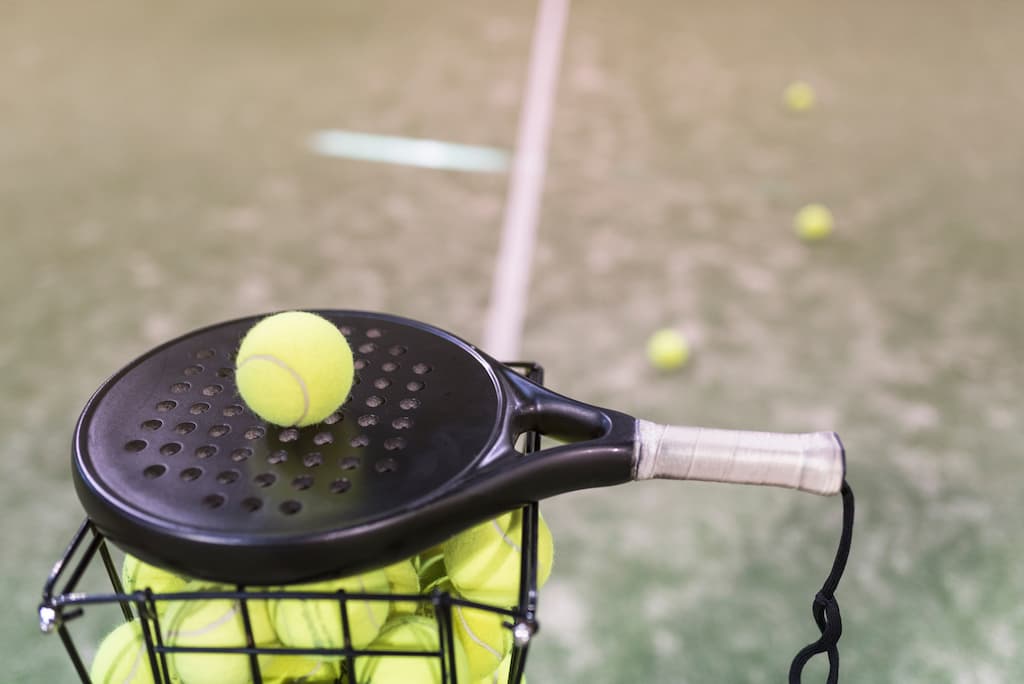Padel is a fun sport that’s a mix of tennis and racquetball. It’s easy to play and loved by people young and old. Lately, a lot more people have started playing it. We’re going to talk about Padel history, how it went from a small game played in backyards to being loved by people all around the world.
Key Takeaways
- Padel is a fast-growing racket sport that combines elements of tennis and squash.
- The sport has its roots in Mexico in the 1960s and has since spread to countries across the globe.
- Padel has a rich and vibrant culture, with its own unique terminology, equipment, and playing styles.
Birth of the Padel
The inception of Padel is a captivating story, painting a vivid picture of its transformation from a local sport in Mexico to a global sensation. Enrique Corcuera, an inventive Mexican businessman, is credited with planting the seeds of Padel in the 1960s. In Acapulco, within the confines of his own backyard, the first ever Padel court came to life.
Combining elements of tennis and squash, Corcuera introduced a game that was designed to be more accessible and less physically demanding. The result was Padel tennis, a sport echoing the agility of tennis yet with an added flair of inclusivity, catering to players of various ages and skills. The history of Padel was thus marked by its unique blend of adaptability and excitement.
Corcuera’s innovation didn’t stop at merging gameplay elements. The birth of the sport saw the introduction of Padel courts distinctly smaller and encased by walls, boasting a net set lower than that of traditional tennis. Padel balls, softer and slower, marked another innovative stride, making the sport not only easier to pick up but also broadly accessible.
The popularity of this engaging sport surged, transcending the confines of the first ever Padel court in Corcuera’s backyard. Its charm was irresistible, and soon Padel became a household name in Mexico.
Yet, the sport’s trajectory didn’t stop there. Amidst the blooming popularity of Padel tennis, another variant, platform tennis, found its footing, offering players a similar yet distinctively rich experience. Each stride, each innovation, weaving the intricate and compelling history of Padel, a narrative of growth, evolution, and unbridled enthusiasm.
The Rise of Padel in Spain
One of the key figures in the rise of Padel in Spain was Alfonso de Hohenlohe, a German prince who settled in Marbella, a coastal town in southern Spain. Hohenlohe was a visionary who saw the potential of Padel and built the first Padel court in Marbella in the early 1970s. He also founded the Marbella Club, a luxury resort that became a hub for the rich and famous who played Padel.
Another important figure in the history of Padel in Spain is Manuel Santana, a former tennis player who won four Grand Slam titles in the 1960s. Santana became a Padel enthusiast and helped to promote the sport in Spain. He also founded the Spanish Padel Association in 1991, which helped to establish a national governing body for the sport.
Today, Padel is hugely popular in Spain, with thousands of courts across the country. The sport is played by people of all ages and abilities, and there are professional Padel players who compete in tournaments around the world.
The popularity of Padel in Spain can be attributed to a number of factors, including the country’s geography. Spain has a warm climate and a coastline that stretches for thousands of kilometers, making it an ideal location for outdoor sports like Padel. In addition, the sport is relatively easy to learn and can be played by people of all ages and abilities.
Padel’s Global Popularity

Padel has not only created a buzz in its country of origin but its appeal has also permeated international borders, making its mark in various nations worldwide. The Padel spread has been notably significant in European countries and the Americas.
In the realm of British Padel, the sport, although newer, is steadily carving a niche. The United Kingdom is witnessing the emergence of numerous Padel clubs, indicating the sport’s escalating popularity. While still stepping out of the shadows of mainstream racket sports like tennis and squash, Padel is on an upward trajectory in terms of recognition and participation.
Italy, another European country, has warmly embraced Padel. With the sport having established roots there for several years, the presence of an array of Padel clubs and the organisation of regular tournaments is testament to its popularity.
Across the pond, in the United States, Padel is in its nascent stages but is showing promising signs of growth. The emergence of clubs dedicated to the sport signifies its budding popularity, offering a dynamic and engaging alternative for staying active.
In Canada, the echo of Padel is softer but unmistakable. While still unfolding its chapters in the Canadian sports narrative, the existence of clubs and a growing interest spotlight Padel as a social and enjoyable way to keep fit and active.
The narrative of Padel is also alive and growing in South America and other Spanish-speaking nations, pointing to the sport’s global allure. Padel, with its unique blend of accessibility and excitement, continues to weave its threads into the fabric of international sports, promising a tapestry rich with diversity, engagement, and global camaraderie.
First Padel Associations and Tournaments
Padel’s ascent in popularity traces back to the 1970s in Spain and is closely tied with the establishment of first Padel associations and pivotal tournaments. In the limelight of its history, organizations like the Spanish Padel Federation, founded in 1985, played a key role in elevating the sport nationally.
As the sport garnered attention, it paved the way for the emergence of the International Padel Federation (FIP) in 1988. It wasn’t just a national rave – countries like Argentina, Brazil, and Uruguay were key players in the global promotion, and it is now acknowledged by the International Olympic Committee, boasting 33 member countries.
A significant milestone in Padel history was the inception of the First World Championships in 1992, hosted in Spain. It was a battleground where Argentina clinched the men’s title and Spain, the women’s. This championship became a biennial event, a tradition that illuminated Spain and Argentina as powerhouses in the sport.
The landscape of Padel was further enriched with the introduction of the World Padel Tour and Padel Pro Tour. These premier circuits, akin to grand slams in tennis, attracted the crème de la crème of Padel players, offering a spectacle of skill and talent and further propelling the sport’s global appeal.
Today, other esteemed competitions like the European Padel Championship and the Americas Padel Cup underscore the sport’s international allure, each tournament weaving its own unique thread in the intricate tapestry of Padel history.
Padel’s Key Features and Popularity
One of the key features of Padel is its accessibility. It is a sport that can be played by people of all ages and skill levels. The smaller court size and the use of walls make it easier for beginners to get started and enjoy the game. Padel also has a strong social aspect, with many players enjoying the game as a way to socialize and stay active.
Padel has become increasingly popular in recent years, particularly in Europe and Latin America. According to the International Padel Federation, there are over 20 million players worldwide, with Spain, Argentina, and Mexico being among the countries with the largest number of players.
The popularity of Padel can be attributed to several factors. One of the main reasons is its fast-paced and exciting gameplay. The use of walls adds an extra dimension to the game and allows for more creative shots and strategies. Padel is also a relatively easy sport to learn, with many clubs and facilities offering lessons and clinics for beginners.
Another factor contributing to Padel’s popularity is its social aspect. Many clubs and facilities offer organized leagues, tournaments, and social events, which provide opportunities for players to meet new people and build relationships. Padel is also a great way to stay active and fit, making it an appealing option for those looking to improve their health and well-being.
Future of Padel
Padel has experienced a significant growth in popularity in recent years, and this trend is expected to continue in the future. The sport has gained a significant following in countries such as Spain, Argentina, and Mexico, and it is slowly spreading to other parts of the world.
Padel courts are smaller than traditional tennis courts, making them easier to build and maintain. Padel also requires less physical effort than tennis, making it an excellent option for people of all ages and fitness levels.
Another factor that is likely to contribute to the growth of Padel is the increasing number of professional tournaments. As more players take up the sport, the competition is likely to become more intense, leading to more exciting matches and more fans.
Technology is also playing a significant role in the future of Padel. Companies are developing new equipment and accessories that are designed to enhance the player’s experience. For example, some companies are developing smart rackets that can track the player’s performance and provide feedback on how to improve their game.
Overall, the future of Padel looks bright. With its accessibility, growing popularity, and technological advancements, Padel is poised to become one of the most popular sports in the world.
Frequently Asked Questions
Who invented the game Padel?
Padel was invented by Enrique Corcuera, a Mexican businessman, in 1969. He wanted to create a sport that could be played in a smaller space than tennis. He built the first Padel court in his backyard in Acapulco, Mexico.
Which country plays the most Padel?
Spain is currently the country where Padel is most popular. It is estimated that there are over 6 million Padel players in Spain. Argentina and Mexico are also countries where Padel is very popular.
Why is Padel not an Olympic sport?
Padel is not currently an Olympic sport because it has not yet been recognized by the International Olympic Committee (IOC). In order to become an Olympic sport, a sport must go through a lengthy process of evaluation and approval by the IOC.
Why is Padel so popular?
Padel is popular because it is a fun and social sport that can be played by people of all ages and skill levels. It is also a great workout that can improve cardiovascular health, agility, and coordination. Additionally, Padel is a relatively easy sport to learn, making it accessible to beginners. Its popularity has been growing rapidly in recent years, especially in Europe and South America.

